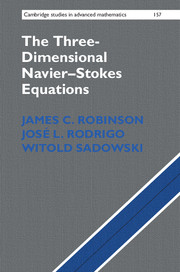3653 results in ebooks in fluid mechanics
Overview of Part I
- from PART I - WEAK AND STRONG SOLUTIONS
-
- Book:
- The Three-Dimensional Navier–Stokes Equations
- Published online:
- 05 September 2016
- Print publication:
- 07 September 2016, pp 17-18
-
- Chapter
- Export citation
12 - Vorticity
- from PART II - LOCAL AND PARTIAL REGULARITY
-
- Book:
- The Three-Dimensional Navier–Stokes Equations
- Published online:
- 05 September 2016
- Print publication:
- 07 September 2016, pp 224-237
-
- Chapter
- Export citation
Appendix D - Estimates for the heat equation
-
- Book:
- The Three-Dimensional Navier–Stokes Equations
- Published online:
- 05 September 2016
- Print publication:
- 07 September 2016, pp 393-406
-
- Chapter
- Export citation
3 - Weak formulation
- from PART I - WEAK AND STRONG SOLUTIONS
-
- Book:
- The Three-Dimensional Navier–Stokes Equations
- Published online:
- 05 September 2016
- Print publication:
- 07 September 2016, pp 70-88
-
- Chapter
- Export citation

The Three-Dimensional Navier–Stokes Equations
- Classical Theory
-
- Published online:
- 05 September 2016
- Print publication:
- 07 September 2016

Bubble and Foam Chemistry
-
- Published online:
- 05 September 2016
- Print publication:
- 08 September 2016
12 - Electromagnetic Flowmeters
-
- Book:
- Flow Measurement Handbook
- Published online:
- 05 August 2016
- Print publication:
- 25 August 2016, pp 362-407
-
- Chapter
- Export citation
18 - Thermal Flowmeters
-
- Book:
- Flow Measurement Handbook
- Published online:
- 05 August 2016
- Print publication:
- 25 August 2016, pp 530-552
-
- Chapter
- Export citation
Main Index
-
- Book:
- Flow Measurement Handbook
- Published online:
- 05 August 2016
- Print publication:
- 25 August 2016, pp 735-738
-
- Chapter
- Export citation
21 - Probes for Local Velocity Measurement in Liquids and Gases
-
- Book:
- Flow Measurement Handbook
- Published online:
- 05 August 2016
- Print publication:
- 25 August 2016, pp 603-616
-
- Chapter
- Export citation
24 - Final Considerations
-
- Book:
- Flow Measurement Handbook
- Published online:
- 05 August 2016
- Print publication:
- 25 August 2016, pp 633-642
-
- Chapter
- Export citation
10 - Turbine and Related Flowmeters
-
- Book:
- Flow Measurement Handbook
- Published online:
- 05 August 2016
- Print publication:
- 25 August 2016, pp 279-326
-
- Chapter
- Export citation
Acknowledgements
-
- Book:
- Flow Measurement Handbook
- Published online:
- 05 August 2016
- Print publication:
- 25 August 2016, pp xxv-xxvi
-
- Chapter
- Export citation
Preface
-
- Book:
- Flow Measurement Handbook
- Published online:
- 05 August 2016
- Print publication:
- 25 August 2016, pp xxiii-xxiv
-
- Chapter
- Export citation
Dedication
-
- Book:
- Flow Measurement Handbook
- Published online:
- 05 August 2016
- Print publication:
- 25 August 2016, pp v-vi
-
- Chapter
- Export citation
8 - Other Momentum-Sensing Meters
-
- Book:
- Flow Measurement Handbook
- Published online:
- 05 August 2016
- Print publication:
- 25 August 2016, pp 195-233
-
- Chapter
- Export citation
9 - Positive Displacement Flowmeters
-
- Book:
- Flow Measurement Handbook
- Published online:
- 05 August 2016
- Print publication:
- 25 August 2016, pp 234-278
-
- Chapter
- Export citation
13 - Magnetic Resonance Flowmeters
-
- Book:
- Flow Measurement Handbook
- Published online:
- 05 August 2016
- Print publication:
- 25 August 2016, pp 408-418
-
- Chapter
- Export citation
22 - Verification and In Situ Methods for Checking Calibration
-
- Book:
- Flow Measurement Handbook
- Published online:
- 05 August 2016
- Print publication:
- 25 August 2016, pp 617-624
-
- Chapter
- Export citation
17 - Multiphase Flowmeters 508
-
- Book:
- Flow Measurement Handbook
- Published online:
- 05 August 2016
- Print publication:
- 25 August 2016, pp 508-529
-
- Chapter
- Export citation
